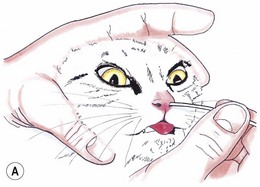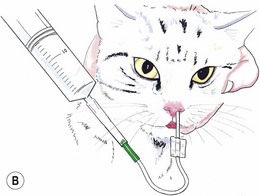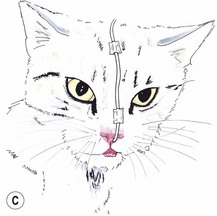Chapter 12 Cats can be notoriously fussy about eating, both while hospitalized and postoperatively, and the importance of maintaining their nutritional status cannot be overemphasized. Adequate nutrition has many benefits including improving the patient’s well-being, optimizing healing and preventing re-feeding syndrome (see Chapter 6). This chapter aims to cover the indications and type of feeding tubes that are available for use in cats and the techniques of tube insertion. There are many reasons why a surgical patient may become inappetent, anorexic, or have inadequate nutritional intake (Box 12-1). It is important that a full assessment is made of both the reasons for inadequate nutritional intake and the options available for overcoming these. Due to their unique nutritional requirements, cats should not be allowed to remain significantly inappetent or anorexic for longer than three days,1 and particular care should be taken of surgical patients where, depending on their condition, nutritional demands may be appreciably higher and inadequate nutritional support may have serious consequences for recovery, morbidity and even mortality. It is well recognized that providing enteral nutritional support, wherever possible, is far superior to attempting parenteral support, being more physiological, safer, less expensive, and preserving the structure and function of the gastrointestinal tract.2 There are occasional situations where parenteral or partial parenteral nutrition is the only realistic option available, but for the vast majority of patients some form of enteral nutritional support can be used. However, the technique used may be dictated, at least to some extent, by the patient’s condition. The presence of orofacial or esophageal disease may, for example, preclude the use of certain tube feeding techniques such as nasoesophageal or esophagostomy tubes. The three most common forms of tube feeding in cats are nasoesophageal tube feeding, esophagostomy tube feeding, and gastrostomy tube feeding (Table 12-1). In occasional patients, feeding via a duodenostomy or jejunostomy tube may be indicated. In the past, pharyngostomy tubes have also been advocated for tube feeding of dogs and cats, but these are now not recommended due to complications such as airway obstruction.2 The selection of feeding tube for any individual patient will depend on a variety of factors as listed in Box 12-2. Orogastric feeding is preferable over feeding that bypasses the stomach, so duodenostomy and jejunostomy tubes are rarely used in cats. There are limited indications for their placement (Box 12-3). Direct surgical placement via the flank is the most common method used,3 and has been reported to have a low complication rate. A modified jejunopexy technique may reduce the risk of leakage around the site of tube entry into the jejunum.4 The reader is referred to Heuter (2004)3 and Daye et al (1999)4 for further details, but this chapter will focus on the three most commonly used techniques of tube feeding. Nasoesophageal tubes are very well tolerated by the majority of cats and have the important advantage of being inexpensive, easy to place and requiring no anesthesia (and usually no sedation) for their placement (Box 12-4). The use of nasoesophageal tubes is particularly valuable in providing short-term nutritional support, but esophagostomy or gastrostomy tubes should generally be considered if tube feeding will need to be provided for longer than around seven days. Additionally, other techniques must be used in cases where nasoesophageal tubes are contraindicated, such as esophageal or gastric dysfunction or persistent vomiting, or perhaps where more aggressive nutritional support is required (due to the wider range of feeds that can be used in wider bore tubes).
Feeding tubes
General considerations
Tube feeding
Feeding tubes
Duodenostomy and jejunostomy tubes
Nasoesophageal intubation
Feeding tubes







